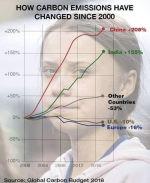You are using an out of date browser. It may not display this or other websites correctly.
You should upgrade or use an alternative browser.
You should upgrade or use an alternative browser.
Carbon emissions
- Thread starter TK4
- Start date
That's kind of a useless graph would be much better with actual numbers of how much not percent
Sent from the future
China is also on a mission to do something about this.
Want to buy solar panels? Where do they come from? China.
What's the biggest market in the world for electric vehicles? China. Who builds the most EVs and the most batteries for EVs? China.

 en.wikipedia.org
en.wikipedia.org
Solar and wind are increasing on a faster percentage rate than other sources. Trouble is, their economy has been expanding faster than any other major economy, so the total demand is increasing, so the absolute amount of generation by fossil fuel is still going up.

 en.wikipedia.org
en.wikipedia.org
There are times when a centrally managed (to some extent ...) economy has its advantages. "You will build a solar power plant." "You will stop operating this coal-fired plant by X date." "You will stop selling gasoline-fueled vehicles by X date." "This city will not allow combustion-engine vehicles to operate within its boundaries by X date". There's none of the political wrangling about consumer preferences. They don't care. As long as the planners get it right ... which they don't always ... but they're onto this issue.
Want to buy solar panels? Where do they come from? China.
What's the biggest market in the world for electric vehicles? China. Who builds the most EVs and the most batteries for EVs? China.

Electricity sector in China - Wikipedia
Solar and wind are increasing on a faster percentage rate than other sources. Trouble is, their economy has been expanding faster than any other major economy, so the total demand is increasing, so the absolute amount of generation by fossil fuel is still going up.

Electricity sector in China - Wikipedia
There are times when a centrally managed (to some extent ...) economy has its advantages. "You will build a solar power plant." "You will stop operating this coal-fired plant by X date." "You will stop selling gasoline-fueled vehicles by X date." "This city will not allow combustion-engine vehicles to operate within its boundaries by X date". There's none of the political wrangling about consumer preferences. They don't care. As long as the planners get it right ... which they don't always ... but they're onto this issue.
China also has far less red tape than we do. If they want to build or destroy something then it takes months not years. They can go hard on infrastructure when they wish to.China is also on a mission to do something about this.
Want to buy solar panels? Where do they come from? China.
What's the biggest market in the world for electric vehicles? China. Who builds the most EVs and the most batteries for EVs? China.

Electricity sector in China - Wikipedia
en.wikipedia.org
Solar and wind are increasing on a faster percentage rate than other sources. Trouble is, their economy has been expanding faster than any other major economy, so the total demand is increasing, so the absolute amount of generation by fossil fuel is still going up.

Electricity sector in China - Wikipedia
en.wikipedia.org
There are times when a centrally managed (to some extent ...) economy has its advantages. "You will build a solar power plant." "You will stop operating this coal-fired plant by X date." "You will stop selling gasoline-fueled vehicles by X date." "This city will not allow combustion-engine vehicles to operate within its boundaries by X date". There's none of the political wrangling about consumer preferences. They don't care. As long as the planners get it right ... which they don't always ... but they're onto this issue.
The numbers are there is you care to look. Not sure how much more you want them to do.
China has the most solar and wind and heading to most nuclear
China has the most solar and wind and heading to most nuclear
China has phenomenal solar power. The nation is the world's greatest solar energy generator, with a record 430 GW of solar capacity (as of April 2023). The country installed more than 30.88 GW of solar PV systems in the first half of 2022.2 Oct 2023
China Built More Offshore Wind In 2021 Than Every Other Country Built In 5 Years China Built More Offshore Wind In 2021 Than Every Other Country Built In 5 Years
and has far and away the most nuclear reactors on the go
China Poised To Surpass The U.S. As The World's Top ...
https://www.forbes.com › sites › rrapier › 2023/09/11
China has far and away the most EVs and banned ICE motorcycles and scooters in major cities.11 Sept 2023 — At the current growth rate, China will surpass the U.S. as the world's largest nuclear power producer within a decade. Top 10 Nuclear Power
China now accounts for nearly 60% of EV sales worldwide. Summary. More than half of the electric vehicles (EVs) on roads worldwide are found in China. In 2022, new EV sales in China grew by 82%, and the country provided 35% of global EV exports.3 Jan 2024
Last edited:
Just as a reminder of what other civilised parts of the world are doing ...

 taxation-customs.ec.europa.eu
taxation-customs.ec.europa.eu

 www.statista.com
www.statista.com
This is a market-established price which has recently ranged between 60 and 100 euro per metric tonne of CO2.
Our carbon pricing is going to C$80 per metric tonne, which is around 55 euro per metric tonne ... not a lot different.
Don't use screwed-up or backward or developing countries as examples of where this should be going. The intent is for carbon pricing to incentivise renewable-source, or at least non-CO2-emitting, energy production. And on that note ...

Carbon Border Adjustment Mechanism
The CBAM will initially apply to imports of certain goods and selected precursors whose production is carbon intensive and at most significant risk of carbon leakage: cement, iron and steel, aluminium, fertilisers, electricity and hydrogen.

EU-ETS price 2022-2024 | Statista
Carbon allowances traded on the European Union Emissions Trading System exceeded 100 euros tCO₂ for the first time in February 2023.
This is a market-established price which has recently ranged between 60 and 100 euro per metric tonne of CO2.
Our carbon pricing is going to C$80 per metric tonne, which is around 55 euro per metric tonne ... not a lot different.
Don't use screwed-up or backward or developing countries as examples of where this should be going. The intent is for carbon pricing to incentivise renewable-source, or at least non-CO2-emitting, energy production. And on that note ...
Priller
Well-known member
Especially when you have massive, well-established industries (with annual revenues in excess of all but four countries' annual GDP) fighting tooth and nail to halt change at every turn...Without incentives, nothing will change.
sburns
Well-known member
$240 for a case of 24's, here we go!Those examples you just mentioned should be good for driving up the prices of goods higher than what they are currently
You do miss the point that China remains an emerging economy - and is taking concrete steps to reduce emissions and that it is per capita that counts.To Slow China was the largest climate polluter, making up nearly 30% of global emissions. top 20 global climate polluters — dominated by China, India, the United States and the European Union — were responsible for 83% of emissions in 2022.Jan 2, 2024
When India surpassed the European Union in total annual greenhouse gas (GHG) emissions in 2019 becoming the third largest emitting country after China and the United States, that statistic only told part of the story. India’s population is nearly three times larger than that of the EU, so based on emissions per person, India ranks much lower among the world’s national emitters.
This is just one of many ways to compare country responsibilities for climate change; there are many other dimensions to climate equity, such as a country’s vulnerability or capacity to act. When focusing on emissions, it’s important to consider population differences and historical contributions, alongside total emissions. That’s why examining a country’s GHG emissions relative to its population — or per capita emissions — provides a helpful perspective.
Using data from Climate Watch — an online platform managed by WRI with open data, visualizations and analysis that provide insights on countries’ climate progress — we analyzed how countries’ per capita emissions compare historically and in the present day.
Among the 10 Highest Emitters, India has the Lowest Per Capita Emissions
China, the United States, India and the EU have the highest total emissions in the world.
But among the top 10 highest emitters, the U.S. and Russia have the highest per capita emissions, at 17.6 tonnes of carbon dioxide equivalent (tC02e) per person and 13.3 tC02e per person respectively, while India’s per capita emissions are the lowest at just 2.5 tCO2e per person.
Of the Top 10 Emitters, the US, Russia, Japan and the EU Have Reduced Per Capita Emissions
When looking at the top 10 total GHG emitters, the EU has reduced its per capita GHG emissions by 29% since 1990 and is now ranked at number 8 (7.04 tCO2e per person), below China (8.6 tCO2e per person) and Indonesia (7.2 tCO2e per person). The U.S. (17.6 tCO2e per person) has reduced its per capita GHG emissions by 19% since 1990. However, this trend in reducing total and per capita GHG emissions for the EU and U.S. is a recent phenomenon.
Russia and Brazil have also reduced their per capita GHG emissions, while Japan’s per capita GHG emissions have barely changed — though they all remain higher than the world average.
Per capita emissions are a function of economic and technological factors, and typically decline as a result of deploying lower-carbon technologies or an economic decline that decreases fossil fuel consumption.
For the U.S., EU, Japan and other advanced economies, reduction of per capita emissions were made possible by deploying low-carbon technologies such as solar and wind power and transitioning from high-emitting fossil fuels like coal to less carbon-intensive sources such as natural gas.
Russia’s reduction of its per capita emissions however was driven by the dissolution of the Soviet Union and the decrease of fossil fuel demand as part of a declining economy. Brazil’s reduction, in contrast, was driven by an increased share of renewables in their energy mix (mostly from hydropower and wind) and a significant reduction in their deforestation rates, implementing policies to protect the Amazon rainforest, a significant carbon sink.
Per Capita Emissions are Rising in Emerging Regions but Have Stabilized Globally
On a regional scale, there is a declining trend in per capita emissions from most industrialized economies, such as those in North America and Europe. This reduction in per capita emissions can be attributed to an uptake in renewables, the use of less carbon intensive fuels, improvements in energy efficiency, among others.
While emerging economies have much lower per capita emissions, they have continuously increased their emissions — except for Sub-Saharan Africa, which declined from 2.63 tCO2e per person to 2.17 tCO2e per person between 1960 and 2019. The main driver behind the increase in most emerging economies comes from their economic growth and reliance on carbon intensive fuels.
The good news is that globally, per capita emissions have not increased since 2010, indicating that the world is slowly diverging from its previous path of carbon intense development.
Polluter pays....perhaps you should question the fossil fuel subsidies handed out in the trillions.Those examples you just mentioned should be good for driving up the prices of goods higher than what they are currently
https://www.imf.org/en/Publications...Fossil-Fuel-Subsidies-Data-2023-Update-537281
by S Black · Cited by 22 — Globally, fossil fuel subsidies were $7 trillion in 2022 or 7.1 percent of GDP. Explicit subsidies (undercharging for supply costs) have more
International Monetary Fund - IMF › Issues › 2023/08/22 › IMF-Foss...
What other choice is there? Nothing big and exciting is happening in renewables. Just a hint for you. Most of the world don't believe in the climate change and the new world wide bullcrap tax they are attaching to itPolluter pays....perhaps you should question the fossil fuel subsidies handed out in the trillions.
IMF Fossil Fuel Subsidies Data: 2023 Update
Last edited:
Well the countries you are castigating certainly do and are taking steps to mitigate it.
Is that your underlying reasoning that YOU don't accept AGW??
Regardless of your view, it is happening, we are responsible and we built western wealth on FF.
FF is not going to disappear but actively disputing the reality of AGW ????
What other choice ??
Is that your underlying reasoning that YOU don't accept AGW??
want to support that with a source?Most of the world don't believe in the climate change
Regardless of your view, it is happening, we are responsible and we built western wealth on FF.
FF is not going to disappear but actively disputing the reality of AGW ????
What other choice ??
Nuclear is growing as is wind but solar is far and away the least expensive regardless of subsidies.Globally, renewables are expected to surpass coal as the largest source of electricity generation by 2025, according to the International Energy Agency (IEA). Wind and solar will lead the transition. In the U.S., the IEA projects that wind and solar capacity will double in 2027 compared to 2021.21 Aug 2023
Solar energy has come a long way over the past few decades, and today it has become the cheapest source of electricity in history, according to the International Energy Agency (IEA).17 Apr 2023
Last edited:
Mad Mike
Well-known member
Remember that part of the civilized world is behind us in a lot of things. The EU depends on coal, gas, and wood for more than 40% of its electricity (they need a bit more civilizing), and about 15% of that is still coal. That's 4x the burn of Ontario, and we use zero coal.Just as a reminder of what other civilised parts of the world are doing ...
Does carbon tax work? I doubt it, I think regulation and incentives are less punishing and more effective.
Ask yourself how much your carbon footprint has dropped since you started paying $500/year in direct taxes, and added another 6 cents/dollar onto everything you buy (average for an Ontarian). Perhaps detail it in a posting.

















